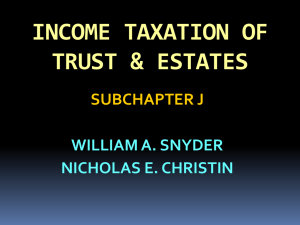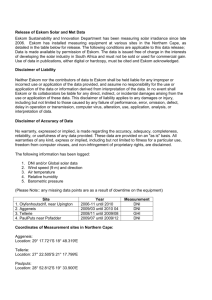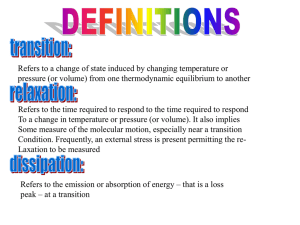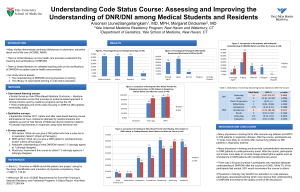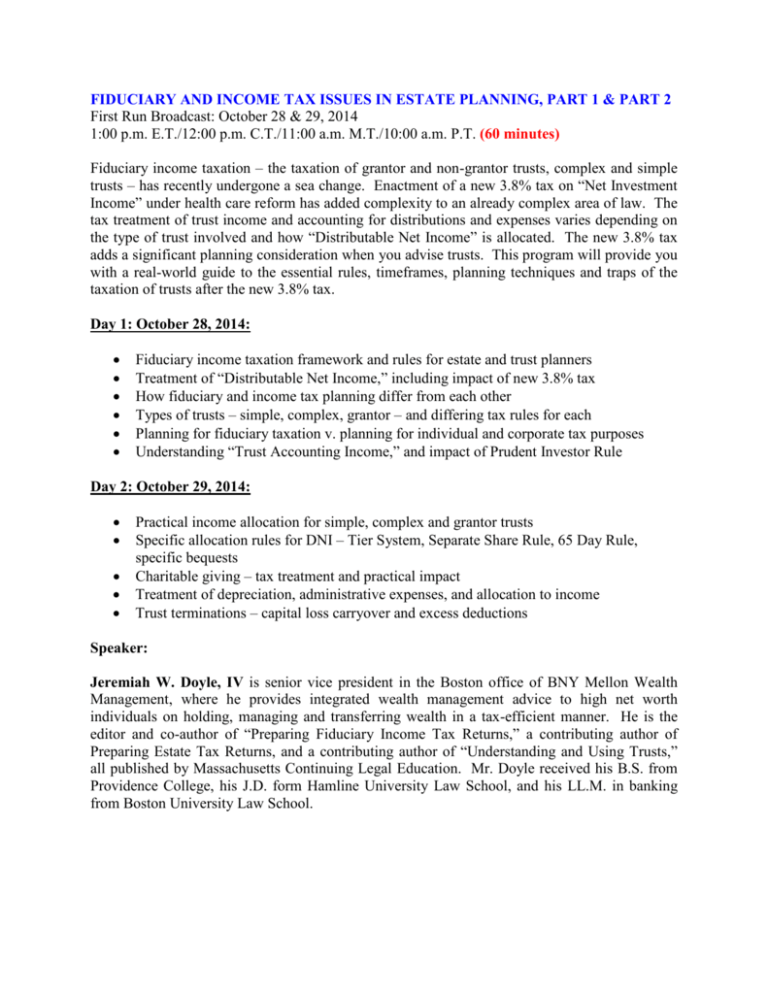
FIDUCIARY AND INCOME TAX ISSUES IN ESTATE PLANNING, PART 1 & PART 2
First Run Broadcast: October 28 & 29, 2014
1:00 p.m. E.T./12:00 p.m. C.T./11:00 a.m. M.T./10:00 a.m. P.T. (60 minutes)
Fiduciary income taxation – the taxation of grantor and non-grantor trusts, complex and simple
trusts – has recently undergone a sea change. Enactment of a new 3.8% tax on “Net Investment
Income” under health care reform has added complexity to an already complex area of law. The
tax treatment of trust income and accounting for distributions and expenses varies depending on
the type of trust involved and how “Distributable Net Income” is allocated. The new 3.8% tax
adds a significant planning consideration when you advise trusts. This program will provide you
with a real-world guide to the essential rules, timeframes, planning techniques and traps of the
taxation of trusts after the new 3.8% tax.
Day 1: October 28, 2014:
•
•
•
•
•
•
Fiduciary income taxation framework and rules for estate and trust planners
Treatment of “Distributable Net Income,” including impact of new 3.8% tax
How fiduciary and income tax planning differ from each other
Types of trusts – simple, complex, grantor – and differing tax rules for each
Planning for fiduciary taxation v. planning for individual and corporate tax purposes
Understanding “Trust Accounting Income,” and impact of Prudent Investor Rule
Day 2: October 29, 2014:
•
•
•
•
•
Practical income allocation for simple, complex and grantor trusts
Specific allocation rules for DNI – Tier System, Separate Share Rule, 65 Day Rule,
specific bequests
Charitable giving – tax treatment and practical impact
Treatment of depreciation, administrative expenses, and allocation to income
Trust terminations – capital loss carryover and excess deductions
Speaker:
Jeremiah W. Doyle, IV is senior vice president in the Boston office of BNY Mellon Wealth
Management, where he provides integrated wealth management advice to high net worth
individuals on holding, managing and transferring wealth in a tax-efficient manner. He is the
editor and co-author of “Preparing Fiduciary Income Tax Returns,” a contributing author of
Preparing Estate Tax Returns, and a contributing author of “Understanding and Using Trusts,”
all published by Massachusetts Continuing Legal Education. Mr. Doyle received his B.S. from
Providence College, his J.D. form Hamline University Law School, and his LL.M. in banking
from Boston University Law School.
VT Bar Association Continuing Legal Education Registration Form
Please complete all of the requested information, print this application, and fax with credit info or
mail it with payment to: Vermont Bar Association, PO Box 100, Montpelier, VT 05601-0100. Fax:
(802) 223-1573 PLEASE USE ONE REGISTRATION FORM PER PERSON.
First Name ________________________ Middle Initial____Last Name___________________________
Firm/Organization _____________________________________________________________________
Address ______________________________________________________________________________
City _________________________________ State ____________ ZIP Code ______________________
Phone # ____________________________Fax # ______________________
E-Mail Address ________________________________________________________________________
Fiduciary & Income Tax Issues in Estate Planning, Part 1
Teleseminar
October 28, 2014
1:00PM – 2:00PM
1.0 MCLE GENERAL CREDITS
VBA Members $75
Non-VBA Members $115
NO REFUNDS AFTER October 21, 2014
PAYMENT METHOD:
Check enclosed (made payable to Vermont Bar Association)
Amount: _________
Credit Card (American Express, Discover, Visa or Mastercard)
Credit Card # _______________________________________ Exp. Date _______________
Cardholder: __________________________________________________________________
VT Bar Association Continuing Legal Education Registration Form
Please complete all of the requested information, print this application, and fax with credit info or
mail it with payment to: Vermont Bar Association, PO Box 100, Montpelier, VT 05601-0100. Fax:
(802) 223-1573 PLEASE USE ONE REGISTRATION FORM PER PERSON.
First Name ________________________ Middle Initial____Last Name___________________________
Firm/Organization _____________________________________________________________________
Address ______________________________________________________________________________
City _________________________________ State ____________ ZIP Code ______________________
Phone # ____________________________Fax # ______________________
E-Mail Address ________________________________________________________________________
Fiduciary & Income Tax Issues in Estate Planning, Part 2
Teleseminar
October 29, 2014
1:00PM – 2:00PM
1.0 MCLE GENERAL CREDITS
VBA Members $75
Non-VBA Members $115
NO REFUNDS AFTER October 22, 2014
PAYMENT METHOD:
Check enclosed (made payable to Vermont Bar Association)
Amount: _________
Credit Card (American Express, Discover, Visa or Mastercard)
Credit Card # _______________________________________ Exp. Date _______________
Cardholder: __________________________________________________________________
Vermont Bar Association
CERTIFICATE OF ATTENDANCE
Please note: This form is for your records in the event you are audited
Sponsor:
Vermont Bar Association
Date:
October 28, 2014
Seminar Title:
Fiduciary & Income Tax Issues in Estate Planning, Part 1
Location:
Teleseminar - LIVE
Credits:
1.0 MCLE General Credit (Program totals 60 minutes)
Luncheon addresses, business meetings, receptions are not to be included in the computation of
credit. This form denotes full attendance. If you arrive late or leave prior to the program ending time, it
is your responsibility to adjust CLE hours accordingly.
Vermont Bar Association
CERTIFICATE OF ATTENDANCE
Please note: This form is for your records in the event you are audited
Sponsor:
Vermont Bar Association
Date:
October 29, 2014
Seminar Title:
Fiduciary & Income Tax Issues in Estate Planning, Part 2
Location:
Teleseminar - LIVE
Credits:
1.0 MCLE General Credit (Program totals 60 minutes)
Luncheon addresses, business meetings, receptions are not to be included in the computation of
credit. This form denotes full attendance. If you arrive late or leave prior to the program ending time, it
is your responsibility to adjust CLE hours accordingly.
Fiduciary Income Taxation Fundamentals
Jeremiah W. Doyle IV
Senior Vice President
BNY Mellon Wealth Management – Boston, MA
(o) (617) 722-7420
jere.doyle@bnymellon.com
©Jeremiah W. Doyle IV
All Rights Reserved
1
What We’ll Cover – Part I, The Basics
•
•
•
•
•
•
•
Structure of Subchapter J
Basic Rules
Distributable Net Income (DNI)
Types of Trusts
Trust Accounting Income (TAI)
Taxable Income
Distribution System – How DNI Gets Allocated
–
–
–
–
•
•
•
•
Tier System
Separate Share Rule
65 Day Rule
Specific Bequests
Charitable Deductions
Depreciation
Terminations – Capital Loss C/O and Excess Deductions
Administration Expenses
– Allocating Expenses to Tax Exempt Income
2
Income Taxation of Trusts and Estates
Code Outline
• PART I, SUBCHAPTER J
–
–
–
–
–
–
Subpart A - Sec. 641-646 - General Rules
Subpart B - Sec. 651-652 - Simple Trusts
Subpart C - Sec. 661-664 - Complex Trusts and CRT
Subpart D - Sec/ 665-668 - Accumulation Distributions
Subpart E - Sec. 671-678 - Grantor Trusts
Subpart F - Sec. 681-685 - Misc. Rules
• PART II, SUBCHAPTER J
–
Sec. 691-692 - Income in Respect of a Decedent
3
Income Taxation of Trusts and Estates
• Separate Taxable Entities
• Taxable Income Computed in Same Manner as Individuals
(Sec. 641(b))
• Own Tax Year and Method of Accounting
• Receive Income/Pay Expenses
• Income Taxed to Entity or Beneficiary
4
2014 Fiduciary Income Tax Rates
Over
Not Over
0
2,500
15%
2,500
5,800
25%
5,800
8,900
28%
8,900
12,150
33%
12,150
39.6%
5
Income Taxation of Trusts and Estates
• Income Taxed to Either Entity or Beneficiary
– If income is accumulated and not deemed distributed, it is
taxed to the trust or estate
– If income distributed:
• Trust gets deduction for amount of distribution
• Beneficiary accounts for income distributed on his own
tax return
6
Income Taxation of Trusts and Estates
DNI
• Distributable Net Income (DNI) governs:
– Amount of trust or estate’s distribution deduction
– Amount beneficiary accounts for on his own return
– Character of income in beneficiary’s hands
7
Income Taxation of Trusts and Estates
DNI
DNI acts as ceiling
on entity’s
distribution
deduction
Trust/Estate
DNI acts as ceiling
on amount
beneficiary
accounts for on his
return
Beneficiary
8
DNI - Sec. 643(a)
•
Start With Taxable Income and . . .
– Add back the distribution deduction
– Add back the personal exemption
– Subtract out capital gains/add back capital losses allocable to
principal (except in the year of termination)
– Subtract out extraordinary dividends and taxable stock dividends
– Add back net tax-exempt income
9
DNI - Sec. 643(a)
• Note: capital gains generally taxed to trust or estate
– Exception: year of termination
•
Note: The rules regarding DNI and the distribution
deduction are applied differently to simple trusts versus complex
trusts and estates
• Distributions of principal as well as income will “carry out” DNI
– Exception: Specific bequests under Sec. 663(a)(1)
10
Types of Trusts
• Simple
• Complex
• Grantor
11
Simple Trust
• Required to distribute accounting income annually
• Makes no principal distributions, and
• Makes no distributions to charity
12
Complex Trust
• Accumulates income
• Makes discretionary distributions of income or mandatory or
discretionary distributions of principal, or
• Makes distributions to charity
13
Grantor Trust
• Grantor or beneficiary has one or more “powers” described in
Sec. 673-678
• Result: All income, expenses and credits “flow through” and are
taxed to the Grantor or beneficiary regardless of whether
distributions are made
• Subpart A-D, Subchapter J (rules for taxation of trusts and
estates) do not apply to Grantor trusts
14
Trust Accounting Income (TAI)
• Governs amount of distributions
• Trustee allocates receipts/disbursements between accounting
income and principal
• Accounting income and principal is determined by governing
instrument or, if instrument silent, by state law
– May be governed by UPIA or unitrust statute
15
Trust Accounting Income (TAI)
Corp Bond Int
TAI
Taxable Income
Capital Gains
Muni Bond Int
Expenses
?
?
16
Trust Accounting Income - TAI
• BACKGROUND
• Prudent Investor Act
– Modern portfolio theory – invest for total return
Replaces the traditional notions of income and
principal
– Enactment of the Uniform Principal and Income Act
– Enactment of Unitrust statutes
17
Trust Accounting Income - TAI
• TRUST ACCOUNTING INCOME
– Could be TAI defined under:
• Traditional definition of income and principal
• Unitrust statute
– Must be no less than 3%, no more than 5% of FMV of
trust assets
• Uniform Principal and Income Act
– Requirements:
» Trust is managed under the Uniform Prudent
Investor Act
» The beneficiary must be eligible for income
distributions
» The distribution is not favorable to one beneficiary
over another
18
Taxable Income of Trust or Estate
• Computed same as individual
• Exemptions: $600/$300/$100
• Different rules for charitable deductions
• Depreciation deduction allocated between entity and beneficiary
• Distribution deduction
• Administration expenses - some not subject to 2% floor
• AGI - same as individual except (a) personal exemption, (2)
distribution deduction and (3) some administration expenses are
subtracted “off the top,” i.e. subtracted from taxable income to
arrive at AGI
19
Distributions - Simple Trust
Beneficiary Taxed on Lower of TAI or DNI
Gains Taxed to Trust
Trust Gets Distribution
Deduction Equal to DNI
Simple
Trust
Gains
DNI
Beneficiary Accounts for DNI
Beneficiary
Trust income retains its
character in Beneficiary’s hands
20
Distributions - Complex Trusts and Estates
Trust/Estate Accumulates Income
Gains and DNI Taxed to
Trust
Complex
Trust
Gains
DNI
21
Distributions - Complex Trusts and Estates
Beneficiary Taxed on Distributions Up to DNI
Gains Taxed to Trust
Trust Gets Distribution
Deduction Equal to
Distributions up to DNI
Complex
Trust
Gains
DNI
Beneficiary Accounts for
Distributions Up to DNI
Beneficiary
Trust income retains its
character in Beneficiary’s hands
22
Distributions - Applicable Code Sections
Simple Trusts
Complex Trusts/
Estates
651
661
652
662
23
Distributions - Applicable Code Sections
Simple Trusts
Distribution
Deduction
Complex Trusts/
Estates
651
661
652
662
24
Distributions - Applicable Code Sections
Simple Trusts
Complex Trusts/
Estates
Distribution
Deduction
651
661
Amt Bene
Accounts For
652
662
25
Allocation of DNI
• FOUR IMPORTANT CONCEPTS:
• Tier System
• Separate Share Rule
• 65 Day Rule (§663(b) election)
• Specific Bequests - §663(a)(1)
26
Complex Trust and Estates
Tier System
• Two tiers:
– First Tier - Distribution of income required to be
distributed currently
– Second Tier - Distribution of all other
credited or required to be distributed
amounts paid,
27
Complex Trust and Estates
Tier System
DNI
First Tier Beneficiary
Second Tier Beneficiary
DNI is taxed first to FTB and any
balance of DNI is taxed to STB
28
Complex Trust and Estates
Tier System - Example
Facts: $40,000 DNI and TAI
Trust requires A receive 50% of income
Trustee makes discretionary
distributions of $20,000 to each B and C
A is FTB (Gets 50% of $40,000 TAI)
B and C are STB (Discretionary Benes)
29
Complex Trust and Estates
Tier System - Example
$40,000 DNI
($20,000) DNI for FTB
$20,000 DNI for STB
2 STB
$10,000 DNI for Each STB
30
Complex Trust and Estates
Tier System - Example
$40,000
DNI
A
B
C
$20,000 DNI
$10,000 DNI
$10,000 DNI
FTB
STB
STB
31
Separate Share Rule
Solely for purposes of computing DNI, substantially separate
and independent shares of different beneficiaries of a trust are
treated as separate trusts.
Effect: Treat multiple beneficiaries of single trust or
estate as if each were the sole beneficiary of a single
trust solely for determining how much DNI each
distribution carries out.
32
Separate Share Rule
Estate has $10,000 DNI for 2013
Two Equal Beneficiaries: A and B
Distributes $10,000 to A in 2013
A taxed on $10,000
Estate has $5,000 DNI for 2014
Distributes $10,000 to B in 2014
B taxed on $5,000
Same amount paid in 2 different years, different tax result
33
Separate Share Rule
Estate has $10,000 DNI for 2013
Two Equal Beneficiaries: A and B
Distributes $10,000 to A in 2013
A taxed on $5,000 ($10,000 DNI/2)
Estate has $5,000 DNI for 2014
Distributes $10,000 to B in 2014
B taxed on $2,500 ($5,000 DNI/2)
DNI computed based on 2 separate shares
34
Separate Share Rule
• Applies to estates and trusts
• DNI computed separately for each share
• Mandatory, not elective
• Only Affects share of DNI
– Doesn’t allow filing multiple returns
– Doesn’t allow separate calculation of tax
35
65 Day Rule aka Sec. 663(b) Election
• Applies to complex trusts and estates
• Allows fiduciary to treat distribution made within 65 days of Y/E as
being made on 12/31 of preceding year
• Election must be made by due date of return
• Election is irrevocable
• Year by year election (e.g. good for 1 year only)
• Limited to > DNI less current year distributions or TAI not
distributed
36
65 Day Rule aka Sec. 663(b) Election
65 Days
2013
2014
12/31
37
65 Day Rule aka Sec. 663(b) Election
Facts: $10,000 DNI for 2013
Distributes $6,000 in 2013, $4,000 in 2014
65 Days
$6,000
2013
$4,000
2014
12/31
38
Specific Bequests - Sec. 663(a)(1)
• Bequest of specific sum of money or specific property do not carry
out DNI
• Requirements:
– Paid all at once, or
– Paid in not more than 3 installments
• Not deductible by trust/estate or taxable to beneficiary
39
Charitable Deduction - Sec. 642(c)
• Requirements:
– Paid from gross income
– Paid pursuant to the governing document
• Unlimited in amount
• No distribution deduction
• Generally, must be actually paid in current year or preceding
year
– Estates and pre- 1969 trusts get charitable deduction if
“permanently set aside”
40
Depreciation - Sec. 642(e)
• Trusts:
– Depreciation apportioned between income beneficiary and
the trust per trust document
– If no provisions in trust, depreciation apportioned on basis of
trust income allocable between bene and trust
• Estates:
– Depreciation allocable on basis of income allocable to bene
and estate
41
Depreciation - Sec. 642(e)
Example
• FACTS:
• Trust owns apartment building
• $2,500 depreciation deduction
• Trust pays all income to beneficiary
Beneficiary is entitled to entire $2,500
depreciation deduction
42
Depreciation - Sec. 642(e)
Exceptions
• GR: Depreciation allocated based in TAI allocated to
trust/estate and beneficiary
• 2 exceptions - both apply to trusts:
– Trust inst or local law indicates who get depreciation
deduction
– Trustee maintains depreciation reserve, trust gets deduction
to extent trustee transfers income to reserve for depreciation
43
Depreciation - Sec. 642(e)
Example
• FACTS:
• Depreciation deduction is $5,000
• TAI is $20,000
• Inst requires trustee to maintain depreciation reserve
• Trustee transfers $5,000 of income for depreciation reserve
• RESULT: Entire $5,000 depreciation deduction is allocated to
trust
44
Termination of Trusts and Estates - Sec. 642(h)/Unused
Loss Carryovers and Excess Deductions
• NOL, capital loss c/o and “excess deductions” pass to the
beneficiary on termination of an estate or trust
• Pass through only in the year of termination
45
Capital Loss C/O
• Unused capital loss c/o passes to beneficiary in year of
termination of trust or estate
• No time limit on beneficiary to use capital loss c/o
46
Capital Loss C/O
Example
• FACTS:
• Trust incurs $30,000 LTCL in 2013.
• Trust terminates in 2014, LTCL c/o still $30,000
• $30,000 LTCL c/o passes to beneficiary on termination
• Beneficiary can use LTCL c/o to offset his own personal
capital gains or, if he has no gains, deduct up to $3,000 each
year against ordinary income
47
“Excess Deductions”
• “Excess deductions” occur where trust/estate expenses exceed
income in year of termination
• “Excess deductions” pass through to beneficiary on termination
of trust/estate
– Beneficiary can deduct on his personal return
• Deductible as miscellaneous itemized deduction subject to 2%
floor
– If beneficiary doesn’t itemize, he can’t use deduction
48
“Excess Deductions”
Example
• FACTS:
• Estate has $30,000 of income and $50,000 executor’s fee
for 2014.
• Estate terminates in 2014
• “Excess deductions” are $20,000 ($30,000 - $50,000)
• Estate reports the $20,000 excess deduction to the
beneficiary on a Form K-1 (“tax letter”)
• Beneficiary can take $20,000 “excess deduction” on his own
personal return as a miscellaneous itemized deduction
subject to the 2% floor
49
Administration Expenses
• Consist of attorney’s fees, accountant’s fees, executor’s
commissions, filing fees, surety bonds premiums, appraisal
fees, etc.
• Deductible on Federal estate tax return (706) or fiduciary
income tax return (1041), but not both
• Fiduciary can elect where to take expenses (706 or 1041) - the
so-called Sec. 642(g) election
• Generally, not subject to 2% floor
– Test: would expenses be uncommon (or unusual or unlikely)
for an individual to incur?
• Generally, claim on return with highest tax rate
50
Non-Deductible Expenses - Sec. 265
• Sec. 265 disallows any deduction attributable to T/E income
• Generally applies to deductions for production of income,
usually trustee’s fees and executor’s fees
• If trust/estate has T/E income, portion of trustee’s and executor’s
fees are nondeductible
• No specific allocation formula
– Fiduciary can use any reasonable method
51
Non-Deductible Expenses - Sec. 265
Example
• FACTS:
• Trust has $30,000 taxable interest and $10,000 T/E interest
• Incurs $20,000 trustee fee
• Portion of trustee fee attributable to T/E income is nondeductible
$10,000 T/E income
x $20,000 fees
= $5,000 non-deductible
$40,000 Total income
52
Example of a 2013 Fiduciary Income Tax Return for
a Complex Trust
53
Facts
• Trust provides that 50% of the income must be paid currently to
Will
• During 2013 the trustee makes the following discretionary
distributions:
– 25% of the income to Cam
– 25% of the income to charity
• No reserve for depreciation is required
Question: What type of trust is this and why?
54
INCOM E
Rents
40,000
Tax Int.
30,000
T/E Int
15,000
LTCG
8,000
EXPENSES
Depr/Rental
6,000
R/E Rent Ex
14,000
Tr Fee-Prin
1,000
Tr Fee-Inc
2,000
Char Ded
Exemption
Total
55
Distribution of Income
Required:
50% to Will
Discretionary: 25% to Cam
25% to Charity
56
INCOM E
TAI
Rents
40,000
40,000
Tax Int.
30,000
30,000
T/E Int
15,000
15,000
LTCG
8,000
-
Depr/Rental
6,000
-
R/E Rent Ex
14,000
(14,000)
Tr Fee-Prin
1,000
-
Tr Fee-Inc
2,000
(2,000)
EXPENSES
Char Ded
Exemption
Total
69,000
57
INCOM E
TAI
Rents
40,000
40,000
Tax Int.
30,000
30,000
T/E Int
15,000
15,000
LTCG
8,000
-
Depr/Rental
6,000
-
R/E Rent Ex
14,000
(14,000)
Tr Fee-Prin
1,000
-
Tr Fee-Inc
2,000
(2,000)
EXPENSES
Char Ded
Exemption
Total
69,000
58
IN C O M E
TAI
R ents
40,000
40,000
T ax Int.
30,000
30,000
T /E Int
15,000
15,000
LTCG
8,000
-
D epr/R ental
6,000
-
R /E R ent E x
14,000
(14,000)
T r Fee-Prin
1,000
-
T r Fee-Inc
2,000
(2,000)
E X PE N SE S
Enter on Form
1041, Sch. B,
Line 8
C har D ed
E xem ption
T otal
69,000
59
Amount of TAI Received by Each Beneficiary
Will:
50% x 69,000 TAI = 34,500
Cam:
25% x 69,000 TAI = 17,250
Charity: 25% x 69,000 TAI = 17,250
Total
69,000
60
INCO M E
TAI
TI
Rents
40,000
40,000
40,000
Tax Int.
30,000
30,000
30,000
T/E Int
15,000
15,000
-
LTCG
8,000
-
8,000
78,000
EXPENSES
Depr/R ental
6,000
-
-
R/E Rent Ex
14,000
(14,000)
(14,000)
Tr Fee-Prin
1,000
-
(2,471)
Tr Fee-Inc
2,000
(2,000)
-
Char Ded
(14,206)
Exem ption
Total
(100)
69,000
47,223
61
INCOM E
TAI
TI
Rents
40,000
40,000
40,000
Tax Int.
30,000
30,000
30,000
T/E Int
15,000
15,000
-
LTCG
8,000
-
8,000
78,000
EXPENSES
Depr/Rental
6,000
-
-
R/E Rent Ex
14,000
(14,000)
(14,000)
Tr Fee-Prin
1,000
-
(2,471)
Tr Fee-Inc
2,000
(2,000)
-
Char Ded
(14,206)
Exemption
Total
Enter on
Form
1041,
Page 1,
Line 17
(100)
69,000
47,223
62
INCO M E
TAI
TI
Rents
40,000
40,000
40,000
Tax Int.
30,000
30,000
30,000
T/E Int
15,000
15,000
-
LTCG
8,000
-
8,000
78,000
EXPENSES
Depr/R ental
6,000
-
-
R/E Rent Ex
14,000
(14,000)
(14,000)
Tr Fee-Prin
1,000
-
(2,471)
Tr Fee-Inc
2,000
(2,000)
-
Char Ded
(14,206)
Exem ption
Total
(100)
69,000
47,223
63
Depreciation Deduction
• No reserve for depreciation
• Depreciation follows accounting income
• All accounting income is distributed to Will, Cam and the charity
• Therefore, the trust is not entitled to deduct any depreciation
• Beneficiaries are entitled to depreciation deduction
64
INCO M E
TAI
TI
Rents
40,000
40,000
40,000
Tax Int.
30,000
30,000
30,000
T/E Int
15,000
15,000
-
LTCG
8,000
-
8,000
78,000
EXPENSES
Depr/R ental
6,000
-
-
R/E Rent Ex
14,000
(14,000)
(14,000)
Tr Fee-Prin
1,000
-
(2,471)
Tr Fee-Inc
2,000
(2,000)
-
Char Ded
(14,206)
Exem ption
Total
(100)
69,000
47,223
65
Trustee Fee Allocable to T/E Income
15,000 T/E Income
85,000 Gross TAI
x
3,000 Total Tr Fees = 529
66
Trustee Fee Allocable to T/E Income
15,000 T/E Income
x
3,000 Total Tr Fees
= 529
85,000 Gross TAI
Non-Deductible
Deductible Tr Fees
(529)
2,471
67
INCO M E
TAI
TI
Rents
40,000
40,000
40,000
Tax Int.
30,000
30,000
30,000
T/E Int
15,000
15,000
-
LTCG
8,000
-
8,000
78,000
EXPENSES
Depr/R ental
6,000
-
-
R/E Rent Ex
14,000
(14,000)
(14,000)
Tr Fee-Prin
1,000
-
(2,471)
Tr Fee-Inc
2,000
(2,000)
-
Char Ded
(14,206)
Exem ption
Total
(100)
69,000
47,223
68
Trustee Fee Allocable to T/E Income
15,000 T/E Income
x
17,250 TAI Charity
85,000 Gross TAI
Non-Deductible
Charitable Deduction
=
3,044
3,044
14,206
69
Calculation of DNI
DNI
TI before Dist Ded
47,223
Add: Exemption
Add: Net T/E Income
Less: ND Tr Fee
Less: ND Char Ded
100
15,000
(529)
(3,044)
11,427
Less: LTCG
(8,000)
DNI
50,750
70
Calculation of DNI
DNI
TI before Dist Ded
47,223
Add: Exemption
Add: Net T/E Income
100
15,000
Less: ND Tr Fee
Less: ND Char Ded
(529)
(3,044)
11,427
Less: LTCG
(8,000)
DNI
50,750
Enter on Form 1041,
Sch. B, Line 7
71
Components of DNI
Gross TAI
47.06% 35.29% 17.65%
Rental Taxable
T/E
Income Interest Interest
40,000
30,000
15,000
100%
Total
85,000
LESS:
Rental Exp
(14,000)
(14,000)
Tr. Fees
(1,412)
(1,059)
(529)
(3,000)
Char Ded
(8,118)
(6,088)
(3,044) (17,250)
Totals
16,470
22,853
11,427
50,750
72
Application of the Tier System
• Will is a FTB - entitled to 50% of the income or $34,500
• Cam is a STB - discretionary distribution of $17,250
• How do we allocate DNI between FTB and STB???
73
Now We’ve Got a Problem!!!
FTB Will gets distribution of $34,500
STB Cam gets distribution of $17,250
Total Distributions
$51,750
But DNI is only $50,750!!!
74
The Tier System Solves Our Problem
Share of DNI
FTB Will - Receives $34,500; limited to
DNI of $50,750
$34,500
STB Cam - Receives $17,250; limited to
remaining DNI: 50,750 less 34,500 or
$16,250
$16,250
Total (Equal to DNI)
$50,750
75
The Tier System Solves Our Problem
Share of DNI
FTB Will - Receives $34,500; limited to
DNI of $50,750
% of DNI
$34,500
67.98
STB Cam - Receives $17,250; limited to
remaining DNI: 50,750 less 34,500 or
$16,250
$16,250
32.02
Total (Equal to DNI)
$50,750
100
76
Remember This??? - Components of DNI
Gross TAI
47.06% 35.29% 17.65%
Rental Taxable
T/E
Income Interest Interest
40,000
30,000
15,000
100%
Total
85,000
(14,000)
(14,000)
LESS:
Rental Exp
Tr. Fees
(1,412)
(1,059)
(529)
(3,000)
Char Ded
(8,118)
(6,088)
(3,044) (17,250)
Totals
16,470
22,853
11,427
50,750
Will and Cam get 67.98% and 32.02%,
respectively, of each of these items
77
Trustee reports these
amounts to Will and
Cam on separate K-1s
Rental
Income
Taxable
Interest
T/E
Interest
Total
67.98%
Will
32.02%
Cam
Total
11,196
5,274
16,470
15,536
7,317
22,853
7,768
3,659
11,427
34,500
16,250
50,750
78
Will Reports
$26,731 of TI
Rental
Income
Taxable
Interest
T/E
Interest
Total
67.98%
Will
32.02%
Cam
Total
11,196
5,274
16,470
15,536
7,317
22,853
7,768
3,659
11,427
34,500
16,250
50,750
79
Cam Reports
$12,592 of TI
Rental
Income
Taxable
Interest
T/E
Interest
Total
67.98%
Will
32.02%
Cam
Total
11,196
5,274
16,470
15,536
7,317
22,853
7,768
3,659
11,427
34,500
16,250
50,750
80
But . . Aren’t We Missing Something???
Taxable Income
Will
Reports
Cam
Reports
$26,731
$12,592
81
YES! - Depreciation
Will
Reports
Cam
Reports
Taxable Income
$26,731
$12,592
Depreciation
(3,000)
(1,500)
Net Taxable Income
$23,731
$11,092
82
Where’s the Other $1,500 of Depreciation?
Will
Reports
Cam
Reports
Taxable Income
$26,731
$12,592
Depreciation
(3,000)
(1,500)
Net Taxable Income
$23,731
$11,092
It is Allocated to Charity and is Wasted!!!
83
The Distribution
Deduction is $39,323
Rental
Income
Taxable
Interest
T/E
Interest
Total
67.98%
Will
32.02%
Cam
Total
11,196
5,274
16,470
15,536
7,317
22,853
7,768
3,659
11,427
34,500
16,250
50,750
84
Trust’s Taxable Income
TI Before Dist Deduction $47,223
Distribution Deduction
Taxable Income
$39,323
$7,900
The taxable income is the LTCG less the $100 exemption
85
Trust’s Taxable Income
TI Before Dist Deduction $47,223
Distribution Deduction
Taxable Income
$39,323
Report on
Form
1041,
Page1,
Line22
$7,900
The taxable income is the LTCG less the $100 exemption
86
Summary
• Compute TAI
• Figure Distribution Beneficiaries Get
• Calculate Taxable Income
– Allocate Depreciation
– Allocate Expenses to T/E Income
• Calculate DNI
• Apply Tier System
– Allocate DNI
• Send K-1s to Beneficiaries
• Complete 1041
• Thank God for Tax Software!!!
87
Summary
• Trust or estate is a separate taxable entity
• Income is taxed to either to estate/trust or beneficiary
• Concept of “distributable net income” (DNI) determines
– Amount of distribution deduction
– Amount included in beneficiary’s income
– Character of income
• DNI affected by
– Tier system of allocating DNI
– Separate share rule
– 65 day rule
– Section 663(a)(1) for specific bequests
• This stuff is really complicated
88
Resources
• Federal Income Taxation of Estates, Trusts and Beneficiaries, 3rd
Edition by Ferguson, Freeland and Ascher (Aspen/CCH)
• 1041 Deskbook (Practitioners Publishing Co)
• Income Taxation of Trusts and Estates, 852-3rd (BNA portfolio –
Estate, Gift and Trust series)
• Federal Income Taxation of Decedents, Estates and Trusts,
David A. Berek (2013 Edition) (CCH)
• Federal Income Taxation of Trusts and Estates, by Zaritsky and
Lane, 3rd Edition (RIA/Thompson/West)
• Income Taxation of Fiduciaries and Beneficiaries by Byrle M.
Abbin, 2 volumes, 2013 Edition (CCH)
89



